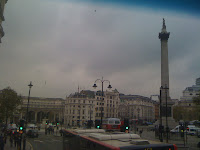Just footsteps from our service apartment is St. Paul's Cathedral...
According to http://www.sacred-destinations.com/england/london-st-pauls-cathedral: London dates from
604 AD, and its cathedral has always been situated on Ludgate Hill and dedicated to St Paul. Long before Christianity arrived in Britain, Ludgate Hill was already a sacred site. It is believed that it was originally the site of an ancient megalith and then later a temple dedicated to the goddess Diana, in alignment with the Apollo Temple which once stood at Westminster.
The first cathedral was built by the Saxons in wood. It burned down in 675 and was rebuilt, again in wood, ten years later. After this version was sacked by the Vikings in 962, the "second" St Paul's built, this time mainly in stone.
The third St Paul's (known as Old St Paul's), was begun by the Normans aftered the late Saxon cathedral suffered in a fire of 1087. Work took over two hundred years, and a great deal was lost in a fire in 1136. Nonetheless the roof was once more built of wood, which was ultimately to doom the building.
The church was "completed" in 1240 but a change of heart soon led to the commencement of an enlargement programme, which was not completed until 1314. The cathedral was however consecrated in 1300. It was the third longest church in Europe at 596 feet (181 metres) and boasted one of Europe's tallest spires at some 489 feet (149 metres).
By the 16th century the building was decaying. In 1549 radical preachers incited a mob to destroy many of the interior decorations. In 1561 the spire was destroyed by lightning and it was not replaced. England's first classical architect Sir Inigo Jones added new west front in the 1630s. "Old St Paul's" was ruined in the Great Fire of London of 1666. While it might have been salvagable, albeit with almost complete reconstruction, a decision was taken to build a new cathedral in a modern style instead. Indeed this had been contemplated even before the fire.
Work on the present cathedral commenced in 1675, and was completed on
October 20, 1708, the 76th birthday of its architect, Sir Christopher Wren (1632-1723). It is built of Portland stone in a late Renaissance to Baroque style. Its impressive dome inspired by St. Peter's Basilica in Rome, rising 108 metres (365 feet to the cross at its summit, i.e., one foot for each day of the year), makes it a famous London landmark.
As the cathedral of the capital city, St. Paul's Cathedral in London has been the spiritual focus of England ever since the first service was held in 1697. Many important events have taken place here over the years, including:
- The funerals of Lord Nelson, the Duke of Wellington and Sir Winston Churchill;
- Jubilee celebrations for Queen Victoria and King George V;
- Peace services marking the end of the First and Second World Wars;
- The launch of the Festival of Britain;
- The Service of Remembrance and Commemoration for September 11, 2001;
- The 80th and 100th birthdays of Queen Elizabeth, the Queen Mother;
- The wedding of Charles, Prince of Wales, to Lady Diana Spencer; and
- The Thanksgiving for the Golden Jubilee of Her Majesty the Queen.
It has also been reported that although damaged during WWII, it was never bombed on purpose by direct order from Hitler. Supposedly, the reflection of the moonlight off the cathedral's dome served as a navigational guide for German bombers. However, this piece of trivia is highly disputed, and is a source of a healthy and passionate debate on one website I visited.




























